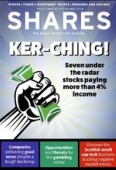Archived article
Please note that tax, investment, pension and ISA rules can change and the information and any views contained in this article may now be inaccurate.
Ker-ching! Seven under the radar stocks and funds paying more than 4% income

Investors are increasingly looking for stocks, bonds or funds that pay a good income.
Dividends or bond coupons provide positive returns which are particularly attractive in a more challenging market such as now.
Many people have this year lost money from backing high-growth but dividend-less stocks such as Tesla (TSLA:NASDQ) and Netflix (NFLX:NASDAQ), and they’re fed up.
In the other side of the ring, tobacco manufacturers, utility providers and mining stocks are currently winning the fight. They’re all big dividend payers, and plenty of investors are playing catch-up, wishing they’d bought these income investments sooner.
A lot of investors have relied on the US market for big returns over the past decade. They may find that’s not the best hunting ground when it comes to income. The S&P 500 index currently trades on a prospective dividend yield of 2.2%, according to SharePad.
In contrast, UK stocks might be a better place to look for income. The FTSE 100 and FTSE 250 offer prospective dividend yields of 3.4% and 3.5% respectively, and it’s easy to find individual stocks yielding a lot more.
With interest rates creeping higher, cash is becoming more competitive for returns. There are fixed-rate cash savings accounts now offering superior rates of interest than you’d get from the S&P 500 equity index for instance.
However, dividends have proved to be a reliable source of income growth over the long run and the growth they offer means they provide a hedge against inflation which cash savings simply do not.
If you are putting money to work in equities, try and look for premium yield to that on offer from the broader markets or a cash savings account, say at least 4%.
Your first port of call might be to hunt around the FTSE 100 index, home to many a dividend-paying stalwart, although the blue chips have already been discovered by investors and are typically mature businesses with pedestrian dividend growth rates.
Therefore, it might be worth considering smaller stocks or funds which remain largely overlooked by investors. There is plenty of choice for sustainable dividends and an attractive level of income, and that’s the focus of the investment ideas in this article.
For small caps, we have screened the market for companies valued at between £20 million and £600 million, offering a minimum yield of 3.5% based on their most recent financial year and a minimum prospective yield of 4% based on forecast payments for the next one and two years.
We have also scoured the investment trust universe for companies offering a minimum yield of 3.5% based on the most recent financial year and a 4% minimum based on their expected payments for the next two years.
And to ensure we aren’t missing out on any hidden gems, Shares has also enlisted the help of some fund managers and research experts for some of their income favourites. Here are six ideas covering a range of asset classes and sectors, all generating attractive levels of income for investors. [JC]
Kitwave (KITW:AIM) 159.75p
Prospective dividend yield: 4.9%
Small cap food and drink wholesaler Kitwave (KITW:AIM) is relatively new to the stock market, yet we are confident it can establish a record of rising payouts. Its dividends are underpinned by a cash generative business model which is centred on consolidating the highly fragmented UK grocery and foodservice wholesale market.
Canaccord Genuity’s year to October 2022 and 2023 estimates point to dividends of 7p and 7.9p respectively, meaning Kitwave offers prospective one and two-year yields of 4.4% and 4.9%, payouts more than twice covered by earnings.
Kitwave delivers sweets, snacks, soft and alcoholic drinks and frozen and chilled food to a diverse customer base which spans convenience stores, pubs, vending machine operators and foodservice providers.
Competitive advantages include an extensive depot network giving nationwide coverage and an in-house fleet of delivery vehicles and drivers.
Admittedly, Kitwave faces uncertainties from cost-of-living pressures impacting end consumers’ disposable income and higher operating costs, although CEO Paul Young is confident rising costs will be recovered. [JC]
Assura (AGR) 70.1p
Prospective dividend yield: 4.4%
Real estate investment trust Assura (AGR) owns and develops medical centres serving GP practices. Almost seven million patients are served across the company’s portfolio.
The shares offer an attractive yield of 4.4% and the company has consistently grown its dividend by around 3% a year on average over the last few years. The firm increased its dividend by 3.9% to 2.93p for the year to March 2022.
Dividends are paid every quarter and Assura says it is now targeting 0.78p per share every three months. That marks its ninth consecutive annual increase in the shareholder payout.
The company has a stable and reliable business and a differentiated offering which means it is well positioned to continue to grow the business and increase the dividend.
Assura has a portfolio worth £2.7 billion, and a development pipeline valued at £522 million.
While the shares trade on a 15% premium to net asset value, they are cheaper than sector peer Primary Health Properties (PHP) which is on a 20% premium. [MG]
Regional REIT (RGL) 84.88p
Prospective dividend yield: 7.6%
While it may not appear as exciting as e-commerce warehouses or infrastructure, investing in high-quality regional offices has proved a successful strategy for Stephen Inglis, manager of Regional REIT (RGL).
With a portfolio of 160 properties worth £874 million as of the end of March, the firm generates around £68 million in rent per year.
At 97%, rent collection is well above London levels, while the value of the assets continues to be revised upward.
In addition, Inglis and his team actively manage the portfolio, adding value by selling properties which have achieved their targets and buying properties with higher returns.
In the past year, £69 million of assets were sold at an average rental yield of 5.9% and £48 million of assets were acquired at a yield of 8.7% which means higher income and the potential for upward revaluation.
The first-quarter dividend increased to 1.6p per share, which annualised means a payout of 6.4p or a yield of 7.6%. [IC]
Disclaimer: The author Ian Conway owns shares in Regional REIT
Watkin Jones (WJG:AIM) 224.95p
Prospective dividend yield: 5%
‘When it comes to unsung dividend heroes, we like Watkin Jones (WJG:AIM), a leading developer, builder, and third-party manager of new homes in the build-to-rent and student accommodation sectors,’ says Chris McVey, manager of Octopus UK Multi Cap Income Fund (BG47Q66).
‘This business benefits from a fantastic, secured development pipeline of circa £2 billion, of which circa £0.6 billion is forward sold giving the group material revenue visibility out to 2025.
‘Watkin Jones also benefits from strong cash generation which underpins an attractive and sustainable prospective 5% dividend yield, but further to this provides the business with balance sheet flexibility offering scope for further organic and inorganic growth.’
XPS Pensions (XPS) 140.5p
Prospective dividend yield: 5.3%
‘On its website, XPS Pensions says it “exists to shape and support safe, robust and well-understood pension schemes for the benefit of people and society”. I buy into that,’ says Gervais Williams, manager of Diverse Income Trust (DIVI).
‘It goes further and says it wants to “become the clearly differentiated alternative firm to the ‘Big 3’ and the pre-eminent mid-tier pensions consulting firm”. I think it is going to get there.
‘I am impressed by XPS Pensions’ collective sense of purpose that is underlined in its latest staff survey where 94% think the company is a good place to work. Furthermore, it had a landmark appointment to the BT (BT.A) pension scheme recently. That turned a few heads.
‘The bottom line is that XPS has a strong record of driving profitable growth that is reflected in a rising stream of dividends.’
Invesco Bond Income Plus (BIPS) 168.21p
Prospective dividend yield: 6.5%
‘Invesco Bond Income Plus (BIPS) invests predominantly in European high-yield bonds and has a good track record, outperforming the ICE BofA European Currency High-Yield index over the past five years,’ says Emma Bird, a research analyst at Winterflood Securities.
‘We view the investment trust’s prospective yield of 6.5% as highly attractive and the 11p per year target dividend for the next three years provides some confidence in it being maintained, particularly given the board’s commitment to use capital reserves if necessary.
‘The merger with Invesco Enhanced Income last year has made the investment trust the largest in its peer group and has also increased its liquidity.
‘In our opinion, this could improve its profile and make it more accessible for a wider range of investors. The rise in size, combined with a reduced management fee of 0.65%, will also lead to a fall in ongoing charges.
‘The investment trust’s shares currently trade at a small discount to NAV, which in our view offers an attractive entry point given that over the past decade they have often traded at a premium. Furthermore, given investors’ continued demand for yield, we would expect the rating to be well-supported if the dividend can be maintained.’
JPMorgan Multi Asset Growth & Income (MATE) 99.61p
Prospective dividend yield: 4.4%
JPMorgan Multi Asset Growth & Income (MATE) has a commitment to grow its dividend at least in line with inflation, as measured by UK CPI,’ says James Carthew, head of investment companies at research group QuotedData.
‘The trust aims to generate both income and capital growth, with lower levels of volatility than a traditional equity portfolio. It operates a multi-asset strategy, maintaining a high degree of flexibility with respect to asset classes, geographies and industry sectors.
‘Dividends are backed by both revenue and distributable reserves. This allows the managers to focus on maximising returns rather than skewing the portfolio towards high yielding investments.
‘The trust has a broad-based portfolio encompassing equities, bonds and alternative investments such as infrastructure. It aims to generate average total returns of 6% per year over five-year periods (share price gains/losses and dividends). Helped by share buybacks where necessary, its shares tend to trade close to net asset value.’
Important information:
These articles are provided by Shares magazine which is published by AJ Bell Media, a part of AJ Bell. Shares is not written by AJ Bell.
Shares is provided for your general information and use and is not a personal recommendation to invest. It is not intended to be relied upon by you in making or not making any investment decisions. The investments referred to in these articles will not be suitable for all investors. If in doubt please seek appropriate independent financial advice.
Investors acting on the information in these articles do so at their own risk and AJ Bell Media and its staff do not accept liability for losses suffered by investors as a result of their investment decisions.
Issue contents
Feature
Great Ideas
- FDM is getting set for growth as it sees record levels of activity
- The sell-off in biotech has gone too far, here's how to take advantage
- Why the sell-off at JD Sports is an unmissable buying opportunity
- Another positive update from one of the UK’s best-run firms
- High street icon delivers an impressive set of results all things considered
News
- Find out why market experts think a summer rally could be on the cards
- ANGLE shares surge 58% after gaining US regulatory approval
- Why Authentic Brands is favourite to bag Ted Baker
- A windfall tax shock puts North Sea oil firms on the spot
- Supermarkets are hoping for a bumper Platinum Jubilee spending spree

 magazine
magazine








